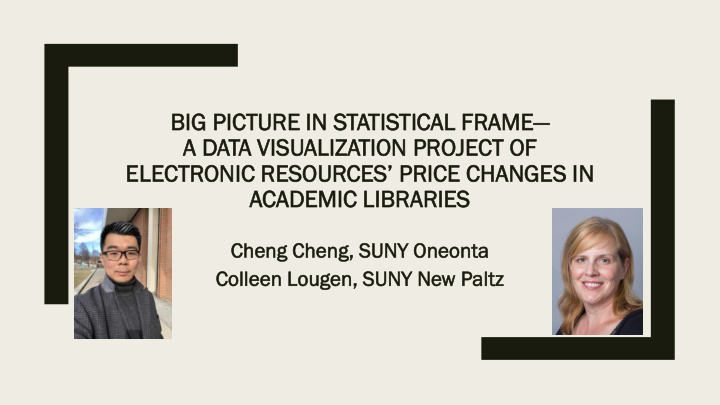



BI BIG PI PICTURE CTURE IN N STATIS TISTI TICA CAL FRAME AME — A DATA VI VISUALIZA ALIZATI TION ON PR PROJECT OJECT OF OF ELECTRONIC RESOURCES’ PRICE CHANGES IN ACADEM ADEMIC IC LIBR BRAR ARIES IES Chen eng g Chen eng, SUNY Oneo eonta Colleen een Louge gen, , SUNY New Pal Paltz
Introduction • Why ??? • Statistics analysis is vital for efficient assets management, and user needs satisfaction • It help us understand user demand, predict future trends, and optimize resources • Statistics analysis is one of the most solid ways to support decision making
Introduction ■ Statistics analysis is a demonstrated tool for operation and strategy optimization ■ Data visualization is the method to make stats understandable for human – Administration and stakeholder need something understandable
Introduction Before:
Introduction • After:
Agenda ■ External price studies and price changing trends -- Colleen ■ Statistical Analysis and Data Visualization project -- Cheng
Library Budgets PCG Ser eria ial l Budg dget et Forec ecast st 2017 14% 29% 29% 53% 53% Budget Budget Increas Increase Static Static Dec Decrea rease se Source: PCG. “Public Communications Group (PCG) Library Budget Predictions for 2017”: http://www.pcgplus.com/wp-content/uploads/2017/05/Library-Budget-Predictions-for-2017- public.pdf
External Price Studies ■ Majority of information is for print-based titles, some online ■ Used to forecast local increases ■ Library Journal’s Periodicals Price Survey ■ Prices of U.S. & Foreign Published Materials Price Index ■ EBSCO’s Serials Price Projection Report
LJ’s Periodical Price Survey ■ “Gathers information from broad sources in order to measure price changes in the marketplace” ■ Uses a print-preferred pricing model on a selected sample of titles
Source: Library Journal. “Periodical Price Survey 2017”: https://lj.libraryjournal.com/2017/04/publishing/new - world-same-model-periodicals-price-survey-2017/#_
Source: Library Journal. “Periodical Price Survey 2017”: https://lj.libraryjournal.com/2017/04/publishing/new - world-same-model-periodicals-price-survey-2017/#_
LJ’s Periodical Price Survey ■ Annual serial price inflation has been around 6% since 2012 and will most likely remain there for 2018 ■ Survey also contains info about: – Current economy – State spending – Spending on education – Library budgets – CPI – Forecast for upcoming year
The Prices of U.S. and Foreign Published Materials Price Index ■ Published by the Association for Library Collections and Technical Services (ALCTS) ■ “A price index will measure the change in price for a limited but consistent set of items.” ■ Contains the U.S. Periodical Price Index (USPPI) table
Source: ALCTS. “Prices of U.S. and Foreign Published Materials- USPPI” https://alair.ala.org/bitstream/handle/11213/8099/LMPI%20Article%202017.pdf?sequence=1&i sAllowed=y
Source: ALCTS. “Prices of U.S. and Foreign Published Materials” https://alair.ala.org/bitstream/handle/11213/8099/LMPI%20Article%202017.pdf?sequence=1&isAllowed=y
EBSCO Serials Price Projection Report • Predicts overall effective publisher price increases for academic and medical libraries for 2018 (before currency impact) to be in the range of 5-6% Source: EBSCO. “2018 EBSCO Serials Price Projection Report”: https://www.ebsco.com/blog/article/2018-ebsco-serials-price-projection-report
Background ■ Need vision for what’s going on in the market ■ Administration and stakeholder need something understandable ■ A practice for future operation
Goal ■ Analyze and visualize the price changing pattern of common electronic resources ■ Provide predictions for future price changes at vendor level ■ Discover any potential cause of such price changes ■ A practice of skills and techniques for statistical analysis and data visualization
Criteria and data cleaning • More than 80 aggregating databases with consistent annual subscriptions from 2010-2015 • No electronic serials, ebooks, one-time purchases and annual access fees were included • Titles without continuing payment records, or have value far away from the mean, were also eliminated
Tools • Office Excel • IBM SPSS • And most importantly…… • ……HUMAN
On the right, we have both price and percent increase of selected resources over years. As we can see, figures show there is a consistent price increase since 2011; The price increases in 2014 and 2015 were fierce
● The projectile (on the right) based on past stats suggest in 2017 and 2018 it may be relatively moderate, which is likely a sign that this price increase cycle is approaching its cap. ● The model for future price prediction is based on the expenditure data from the previous years, and that value varies based on vendor. ● It is important to note that the further into the future the prediction, the less accurate it is. ● It is also important to note that compare to the enormous size of the aggregating databases market with numerous products available, this project only covered a very small facet of it.
Compared the price changing trends and the picture of general economy (up) at the same period, it is very obvious that the pricing trend has been influenced by the national economy trend
The connection between usage and cost is less obvious, although resources with higher usage tend to cost more, probably because to vendors, high usage indicates high-demand.
What we learned ■ Provide visualized trend of Electronic Resources price changes ■ Prediction for future price change ■ It proved that a statistical analysis and data visualization project could be done in small academic libraries without any additional cost.
What we learned ■ Available tool is the best tool ■ Vision and goal ■ Don’t be overwhelming regarding project scale ■ Bigger pool, bigger fun
What we learned ■ Be consistent ■ Legal and liabilities
Thank you!!
Recommend
More recommend